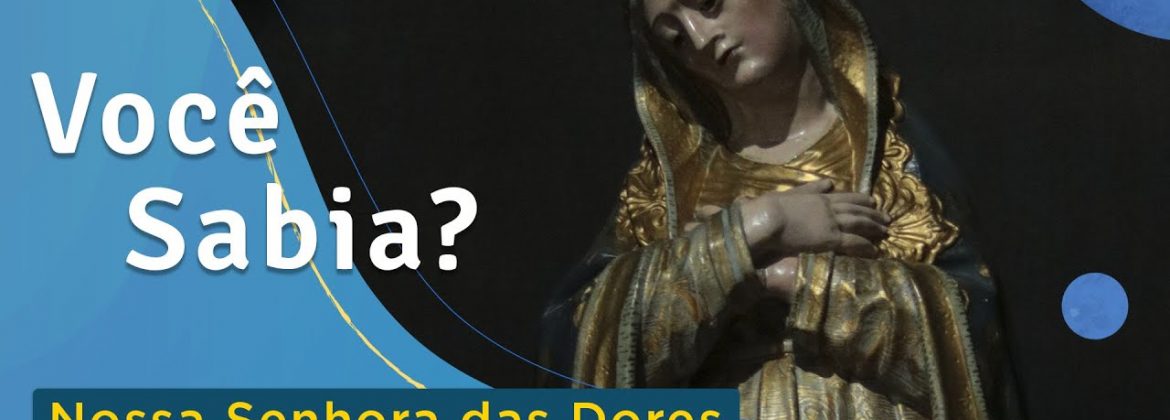Você sabia que Nossa Senhora das Dores ou Mãe Dolorosa é um dos vários títulos que a Virgem Maria recebeu ao longo da história?
Este título em particular refere-se às sete dores que Nossa Senhora sofreu ao longo de sua vida terrestre, principalmente nos momentos da Paixão de Cristo. O culto a Nossa Senhora das Dores iniciou-se no ano 1221 no Mosteiro de Schönau, na então Germânia, hoje, Alemanha.
A festa de Nossa Senhora das Dores como hoje a conhecemos, celebrada em 15 de setembro, teve início em Florença, na Itália, no ano de 1239 através da Ordem dos Servos de Maria, uma ordem profundamente mariana. Nossa Senhora das Dores é representada com um semblante de dor e sofrimento, tendo sete espadas ferindo seu imaculado coração.
Às vezes, uma só espada transpassou seu coração, simbolizando todas as dores que ela sofreu. Ela é também representada com uma expressão sofrida diante da Cruz, contemplando o filho morto. Foi daí que se originou o hino medieval chamado Stabat Mater Dolorosa (Estava a Mãe Dolorosa). Ela ainda é representada segurando Jesus morto nos braços, depois de seu corpo ser descido da Cruz, dando assim origem à famosa escultura chamada Pietà.
Foi aos pés da Cruz, quando Maria viveu a sua dor mais crucial, que ela recebeu do Filho a missão de ser a Mãe de todos homens, Mãe da Igreja (Corpo Místico), Mãe de todos os fiéis. Foi naquele momento de dor que Jesus disse a ela: Mãe, eis aí o teu filho (este filho está simbolizando a todos os fiéis). Foi nesse mesmo momento que Jesus disse a São João, que ali representava a todos nós: Filho, eis aí tua mãe. É por isso que Nossa Senhora é o caminho até Jesus Cristos e assim representada nos espaços litúrgicos e celebrativos, a sua importância para todos os cristãos.
No Museu de Arte Sacra de Mato Grosso temos uma imaginária de Nossa Senhora das Dores datada do século XVIII, proveniente da igreja Nosso senhor dos Passos em Cuiabá. A peça talhada em madeira possui traços fundamentalmente barroco, com pigmentação policromada e carnação rosa claro. Apresenta olhos de vidro e orifícios para a anexação do resplendor.
English Version
Did you know that Our Lady of Sorrows or Sorrowful Mother is one of several titles that the Virgin Mary has received throughout history?
This particular title refers to the seven pains that Our Lady suffered throughout her earthly life, especially in the moments of the Passion of Christ. The cult of Our Lady of Sorrows began in 1221 at the Schönau Monastery, in then Germania, today, Germany.
The feast of Our Lady of Sorrows as we know it today, celebrated on September 15, began in Florence, Italy, in the year 1239 through the Order of the Servants of Mary, a profoundly Marian order. Our Lady of Sorrows is represented with a face of pain and suffering, having seven swords wounding her immaculate heart.
Sometimes, a single sword pierced her heart, symbolizing all the pain she suffered. She is also represented with an expression suffered in front of the Cross, contemplating the dead son. It was from there that the medieval hymn called Stabat Mater Dolorosa (Mother Dolorosa Was) originated. She is still depicted holding Jesus dead in her arms, after his body was taken down from the Cross, thus giving rise to the famous sculpture called Pietà.
It was at the foot of the Cross, when Mary experienced her most crucial pain, that she received from her Son the mission of being the Mother of all men, Mother of the Church (Mystical Body), Mother of all the faithful. It was in that moment of pain that Jesus said to her: Mother, here is your son (this son is symbolizing all the faithful). It was at that very moment that Jesus said to Saint John, who there represented us all: Son, here is your mother. That is why Our Lady is the way to Jesus Christ and is thus represented in liturgical and celebratory spaces, its importance for all Christians.
In the Museum of Sacred Art of Mato Grosso we have an imaginary of Nossa Senhora das Dores dating from the 18th century, from the church Nosso Senhor dos Passos in Cuiabá. The piece carved in wood has basically baroque features, with polychrome pigmentation and light pink flesh. It has glass eyes and holes for attaching the radiance.

